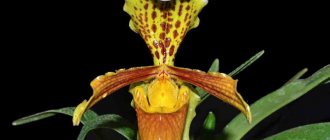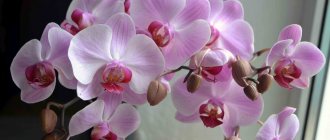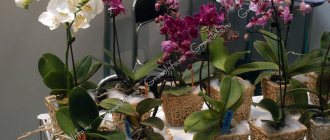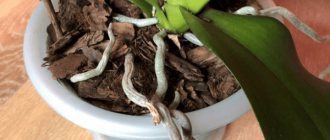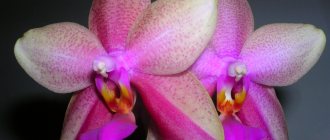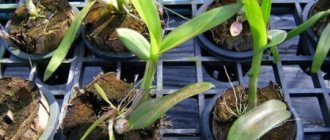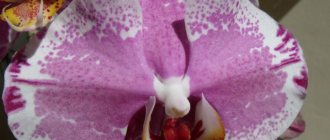Phalaenopsis and Paciopedilum are among the most common types of orchids that are in high demand among buyers and gardeners. So, having studied the basics of caring for them (watering, pruning, replanting, fertilizing, installing supports), the gardener will receive a healthy and beautiful flower for sale, at a high price!
In its homeland in Asia, this orchid grows in humid tropical forests in soil rich in humus. Therefore, it does not need storage organs such as pseudobulbs, which many orchids have. But it is very sensitive to lack of moisture.
- Growth type: sympodial without pseudobulbs
- Temperature: for the general group: 15-20 °C during the day, 10-15 °C at night; for spotted and multi-flowered: 18-27 °C during the day, 16-21 °C at night
- Daily temperature changes: 10-11 °C (general); 5-6 °C (spotted and multi-flowered)
- Flowering duration: 6-10 weeks
- Flowering time: autumn, winter, sometimes spring (new speciesA species is an evolutionarily established set of individuals, characterized by a single...)
- Flowering frequency: from 8 months to 1 year
- Flower color: white, yellow, pink, purple, brown, green
- Place: a window facing north or east, or west, but with transparent curtains.
Paphiopedilum orchids are divided into three groups according to morphological characteristics:
- general, with a large flower, often the only one on the peduncle, and green, usually shiny leaves;
- spotted, with leaves of different shades of green, with a single oval-shaped flower on the peduncle;
- multi-flowered, the flowers have colorful colors and bloom on a single peduncle.
Location and support
Paphiopedilum is quite light-loving, but prefers diffused rays to direct sunlight. Place the plant on the windowsill so that the top of the pot is well lit, turn the pot with young shoots towards the glass. Place a tray with large, constantly wet expanded clay under the container.
If the lighting is too intense, the orchid will “give a signal”: the color of the leaves will first become olive, and then they will quickly turn yellow.
Paphiopedilum is most often sold with supports. After purchasing the plant, the support should be left, as it helps the peduncle not to break due to the weight of the flowers.
Humidity
Humidity is almost as important for plants as adequate lighting. A humidity of 50% is quite sufficient for this type of orchids, although they can briefly survive in drier air up to 30% (I know this from my own example). There are a few things that can help you cope with insufficient humidity.
- Humidifier. But it cannot be placed very close to flowers, the flowers freeze and drop their buds (tested from personal experience).
- Wet expanded clay in a tray. Effectively increases humidity. Promotes the accumulation of salts in the pan. But the pallet may be favored by flies or mosquitoes.
- Orchidarium. An effective remedy - a solution to almost all problems. Expensive.
- Spraying. Gives a short-term effect, promotes the accumulation of water in the axils of the leaves, which can lead to rotting. Water is removed from the leaf axils with a cotton swab.
Pruning and watering
When all the flowers have withered, trim the flower stalk with pruning shears slightly above the base to avoid damaging the leaves. The remaining part of the peduncle will subsequently dry out and will be easy to remove.
Before watering, to avoid plant rotting, remove yellowed leaves. To do this, cut them lengthwise into two parts and carefully pull them out, holding the plant with your other hand so as not to accidentally pull it out of the pot.
Make sure the substrate is kept moist at all times. Check the humidity with your finger, dipping it 1-2 cm into the substrate. Water the plant regularly with soft water, preferably in the morning. Make sure that water does not get on flowers, young shoots and leaves. Paphiopedilum is very susceptible to decay.
Substrate
Phalaenopsis is an amazingly beautiful plant and extremely unpretentious to living conditions; moreover, it is an epiphyte, that is, a plant that uses other trees for support.
Accordingly, in order to create conditions as close as possible to their natural conditions, they should be grown in tree bark; pine bark is best suited in the middle zone. Pine bark should be collected from freshly felled trees so that the decomposition period of the substrate is longer. Decomposed bark loses its breathability and dries more slowly, which leads to rotting of the roots. Therefore, when the substrate decomposes, phalaenopsis should be transplanted into fresh bark to avoid further inconveniences associated with resuscitation of the plant. In order to destroy the spores of fungi and pests living in the forest on pine trees, it is best to boil the substrate for 20-30 minutes, or boil it in a microwave oven. The bark should be dried for 12 hours, then you can use it to plant your pet. Be sure to use drainage; these can be either pieces of polystyrene foam 2-3 cm in size, or regular drainage sold in stores. You can put a layer of sphagnum moss on top of the bark; it will slow down the drying of the substrate.
Fertilizer and replanting
It is preferable to use liquid fertilizer for indoor decorative foliage plants. The dose should be half that recommended on the package! Fertilize your orchid every 15 days. Stop doing this when the young leaves reach the same size as the old ones and new flower stalks appear.
In order for orchids from the first group to bloom, they must be kept outdoors from June to September. SpeciesA species is an evolutionarily established set of individuals, characterized by a single ... from the group of spotted and multi-flowered ones, they do not need the coolness of the night to bloom, but they can also be outdoors in the summer - in the garden or on the balcony.
Once a year, not in winter and not during the flowering period, but during the formation of new shoots, paphiopedilum can be replanted. Carefully remove the orchid from the pot and free the roots from any remaining substrate. Carefully examine the roots and remove damaged or rotten ones with pruners. The instrument must be previously disinfected.
Place drainage at the bottom of the pot. Then fill the pot with substrate. The substrate level should be 1-2 cm below the edge of the pot. Distribute the plant evenly. Gently straighten the roots.
Composition of the mixture: 10% medium-fraction expanded clay, 30% sphagnum and 60% medium-sized pine bark. Be sure to moisten the mixture before use.
Pour the mixture into the pot and tamp it down with a stick. Before new shoots appear (after 3-4 weeks), do not water the orchid, but simply spray the surface of the substrate with water daily.
Signs that an orchid needs replanting
You can simply set a schedule to repot your orchid every couple of years until the plant becomes dangerously overcrowded and everything seems to be fine. Simply trim off the old leaf when it dies and trim the flower stalk when it finishes blooming.
Otherwise, look for signs that the plant needs a new pot. As new leaves grow, the old leaves underneath die off. This means that under the new growth the stem becomes leggy and open aerial roots develop. The result is a tattered, top-heavy plant. When new leaves appear and old ones die off, it’s time to replant the tree, but this is not the only reason.
You should also repot if your orchid is potted with bark potting mix, when the bark decomposes it does not provide good drainage and will need to be replaced.
It is not recommended to replant flowering phalaenopsis orchids. You can repot at any time during the growing season, but try not to repot while your plant is in flower.
This will cause the flowers to fall off. Wait until the plant completes its flowering cycle, then trim off the spike and dead leaf and replant the plant. Good preparation means a flawless repotting When you're ready to repot your plant, make sure you have all the materials on hand to make the process quick and easy. This reduces the stress on you and the orchid!
Here's what you'll need for professional work:
- A bucket of water that was allowed to sit for a day
- Suitable soil mixture for orchids
- Set of sharp sterile pruners
- Suitable pan or container
- Brand new razor blade
- Pair of scissors
You can purchase potting media specially prepared for orchids at your local garden center or make your own. Here is a good recipe for Phalaenopsis orchid mix.
Here's what you'll need:
- Garden charcoal
- Fresh fir bark
- Perlite
Note : spruce bark should be in the form of pieces from 0.6 to 1.3 cm. Charcoal should also be specially prepared for use in gardening; Barbecue charcoal is not suitable. Perlite is readily available as a gardening material.
Other good media options include lava, coconut shells, gravel, and rocks.
Reproduction
The largest speciesA species is an evolutionarily established collection of individuals, characterized by a single ... produce up to two new shoots at the same time, which appear either during or after the flowering of the plant. The oldest leaves usually do not die back until the next bloom.
Divide the large plant into two parts with your hands. In this case, one new shoot should remain in each of them. Plant divisions in the substrate (see advice on page 151) and spray its surface with water until new roots appear.
How to choose and buy phalaenopsis orchids
Here are some tips on what to look for when purchasing a plant:
- The foliage should be firm, clean, unblemished, medium green in color and free of any visible pests. Remember that some leaves have natural speckles.
- There must be roots in the growing medium.
Phalaenopsis flowers
- The peduncle should be held above the foliage on a strong, well-supported spike. Many manufacturers use bamboo colas to make transportation easier.
- Without any unnatural stains
- A phalaenopsis spikelet should have several unopened flower buds. You can never judge the flower life on your plant after all the flowers have bloomed.
Phalaenopsis
In 1980, it became possible to clone this orchid in vitro. Since then it has become very common due to its luxurious flowers and long flowering period. This orchid easily adapts to home conditions.
- Growth type: monopodial
- Temperature: 22-30 °C during the day, 18-25 °C at night
- Daily temperature changes: 2-5 °C
- Flowering duration: 2 months minimum, sometimes longer
- Flowering time: all year
- Flowering frequency: variable
- Flower color: everything except blue
- Place: east or west window.
Description
Leaf blades are an important component of the orchid's appearance. They are always fleshy, large, and can be green or dark green. The leaves are often covered with a silvery coating on top (in the form of transverse stripes), and underneath they are purple or red. The foliage is wide, long - grows up to 45 cm in length, their shape is oval.
In the homeland of the Schiller variety, the Philippines, it received the second name “tiger” because of the pale stripes on the petals. The color of the buds is soft pink with white stripes.
The rhizomes are flat, like other types of phalaenopsis. They are distinguished by a silver-green tint. When watering the plant, the color of the roots becomes richer.
Peduncles grow up to a meter in length, most often they curl. The color of the peduncle can be red or brown. If you tie the peduncle to a support, it can grow in the form of an arch.
Up to four flowers can develop on a plant at the same time.
Location and support
Phalaenopsis needs a high, but not excessive level of substrate moisture, so its roots, if there is a lack of moisture, extend beyond the pot to absorb water from the air. Place the container with the plant on a tray with wet expanded clay. Place a grate between the pot and the expanded clay to prevent the drainage holes from becoming clogged.
Transparent containers are suitable for phalaenopsis. They are convenient because they make it easy to check the condition of the roots; if they suddenly begin to rot due to excess moisture or shrinkage of the substrate. If you notice damage, you need to replant the plant.
The pot should be selected so that its diameter is two fingers wider than the pot, and its height should be 5-6 cm greater. In this case, the edges of the pot and the flowerpot should match, so take a soft mesh, roll it up and place it under the pot to raise it a little.
In order for the container with the plant to become more stable, the peduncle will need support. Bury the support into the substrate in close proximity to the peduncle without damaging the roots. Attach the support to the peduncle in two places using clips. The support should be installed before the buds bloom, as flowers fade faster if their position is changed after blooming.
What are the best pots for phalaenopsis orchids?
You may be tempted to give your orchid a little more root space in hopes of delaying repotting, but this is actually a very bad idea. Monopodial orchids grow best when the roots are close together. If they have room to grow, flowering will be negatively affected.
When you choose a new pot, it should be only slightly larger than the existing one. In fact, it may be the same size if you have quite a few dead roots that need trimming. The idea is to give the plant a fresh potting mix and some wiggle room for the root.
Many orchid lovers use special pots with slits on the sides for greater ventilation of the roots, but this is not entirely important. When you choose a pot made of a material that allows air circulation, you don't have to worry as much about the structure of the pot. Clay pots are porous and durable, so they offer several benefits. They provide good root aeration and provide weight to prevent slightly overloaded plants from tipping over. However, many growers prefer plastic pots. The advantage of plastic is that it is inexpensive and its water-holding properties are valuable to gardeners who rarely water. No matter what type of utensil you choose, make sure it is brand new or thoroughly sterilized.
You can sterilize used pans by soaking them in hot water for a long time using dish soap and bleach. The ratio of bleach to water should be 9:1. Soak the pots for a couple of hours; rub them and rinse thoroughly. Plastic pots can be dried and used immediately. Clay pots need to air out for a couple of days to allow all the bleach fumes to dissipate. Bleach can damage plant roots.
Pruning and watering
When the plant has completely bloomed, cut the flower stalk at the level of the 2nd or 3rd thickening from the base of the plant. In 80% of cases, one of these thickenings (nests) will produce a new peduncle after two or three months. After secondary flowering, trim the peduncle at the very base.
Dried leaves of phalaenopsis do not need to be removed, because they fall off on their own.
Once a week, water the orchid with soft water at room temperature, the volume of which should be equivalent to the volume of the pot. Leave for a few minutes, then drain the excess water and place the plant in the pot. Do not leave the substrate dry: the fleshy leaves should not become soft between two waterings.
If the leaves begin to yellow and dry out at the base of the plant, this is normal. Phalaenopsis should not have more than 4-6 leaves at a time. As new leaves grow, the oldest ones die off. rain moisture enters.
When watering or spraying, water from the watering can should not fall on the flowers and leaves so that they do not rot. During the hot season or winter, if the room is very heated and the air is dry, spray the back of the leaves with soft water at room temperature, especially for miniature species.
Good air circulation is very important
Although keeping your orchid in a draft is not a good idea due to problems with bud drop and another condition known as blight, which appears as dry brown leaf tips and shriveled stems, it is a good idea to keep some air movement. Smoothly moving air promotes good exchange of carbon dioxide, which helps the orchid grow. A smoothly rotating overhead fan or freestanding fan directed away from your plants also helps evaporate excess moisture that can cause fungal infection and other flower stalk and leaf diseases
Fertilizer and replanting
Throughout the year, with the exception of the period between the flowering of the plant and the appearance of new shoots, add special fertilizer during watering once - from spring to autumn and twice - in winter.
To encourage secondary flowering, add a special fertilizer for flowering orchids from the end of the growing season until new leaves emerge after flowering.
Phalaenopsis does not need regular replanting. Only if the roots have filled the entire pot and signs of decay are visible, in the spring or summer, after flowering, carefully remove the plant from the pot. Free the roots from any remaining substrate.
Do not cut off aerial roots, even if they seem dry. In fact, they function normally. Remove dry or rotten roots with sharp, disinfected pruning shears. Trim them as close to the base as possible. After this operation, disinfect the pruning shears again.
The substrate for phalaenopsis should consist of 80% medium-sized pine bark and 20% medium-sized expanded clay. You can add a little sphagnum to increase the moisture capacity of the substrate, but in this case, be careful not to overwater. Moisten the mixture before use.
Take a pot slightly larger than the previous one and fill it with the wet mixture (see tip above). The level of the filled substrate should be 2 cm below the edge of the pot. Place the plant in the center. Add the substrate so that the base of the plant - the neck - remains above its level. Tamp the mixture with a stick from time to time. Do not water the orchid until new shoots appear (after 2-3 weeks). It is enough to spray the surface of the substrate with soft water at room temperature (avoid getting water into the core of the plant).
Butterfly or Moth Orchid - Phalaenopsis (Phalaenopsis), types, content
Orchids cannot be classified as plants that are easy to grow, and this is understandable - at the moment there are more than 25,000 species of orchids and 100,000 cultivars, among which there are indeed many rather capricious orchids.
However, at the end of winter, all garden centers are filled with blooming phalaenopsis, which is very difficult to resist buying, especially considering the variety of colors and shapes of flowers, which sometimes stay on the orchid for up to 3 months.
The name Phalaenopsis literally translates to "moth-like", from the Greek "phalaina" (moth) and "opsis" (appearance), as the flowers of phalaenopsis resemble a fluttering butterfly. Phalaenopsis bloom, as a rule, in late winter - early spring; some species and hybrids can bloom up to 3 months a year, gradually and consistently opening more and more new flowers on long, sometimes branched, gracefully curving peduncles.
Phalaenopsis are monopodial plants with a greatly shortened stem and wide leathery leaves 5-40 cm long. An adult plant usually has 4-6 leaves, some species have no more than 3, and hybrids have 8 or more.
The genus Phalaenopsis consists of more than 50 species and has more than 20 morphologically similar genera; accordingly, the scope for interspecific and intergeneric hybridization is unusually wide.
sogo vivien variegated
phalaenopsis shilleriana
The full cycle of hybridization from seed to flowering plant takes only 3-4 years, whereas, for example, Paphiopedilum hybridization takes at least 7-8 years. Despite the fact that in the process of hybridization the probability of obtaining a truly worthwhile hybrid is one in a thousand, every year thousands and thousands of new hybrids appear on the market.
So, first, a little tediousness for those who are seriously interested in phalaenopsis and collect not hybrid industrial phalaenopsis, but species rarities that do not attract ordinary gardeners.
Phalaenopsis Big Lip
Phalaenopsis Andorra
Phalaenopsis (lat. Phalaenopsis) is a genus of mainly epiphytic, sometimes lithophytic and even terrestrial herbaceous plants of the Orchidaceae family.
Each species of phalaenopsis has its own unique habitat that is critical to survival - temperature, humidity, amount of light - and this means that they cannot be grown in the same conditions. This applies not only to phalaenopsis, but also to all genera of orchids, for example, Paph. rothschildianum and Paph. micranthum require different maintenance conditions.
Most species of phalaenopsis are epiphytes growing on trees. It is worth paying attention to the fact that they are not parasites, i.e., they do not receive nutrients from the trees on which they grow. In nature, they are found in humid lowland and mountain forests from Southeast Asia to the Philippines, New Guinea and Australia. In the wild, areas of natural growth of epiphytic phalaenopsis are characterized by constant warm and humid weather, the aerial roots of phalaenopsis with a thick layer of velamen (a thick spongy outer layer of cells on the roots of epiphytic orchids that absorb moisture from the environment) emerge from the axils of the leaves and can hang down to 1 meter and more. With the help of these aerial roots, phalaenopsis obtain everything they need for life support from the air and precipitation.
Phalaenopsis venosa
Epiphytic species of phalaenopsis (grow on trees):
- amabilis, aphrodite, braceana, celebensis, chibae, cochlearis, corningiana, cornu-cervi, deliciosa, doweryensis, equestris, fasciata, fimbriata, floresensis, fuscata, gibbosa, gigantea, hainanensis, hieroglyphica, honghenensis, inscriptiosinensis, javanica, kunstleri, lindenii, lobbii, lowii, lueddemanniana, maculata, mannii, mariae, micholitzii, , modesta, pallens, pantherina, parishii, philippinensis, pulchra, reichenbachiana, sanderiana, schilleriana, speciosa, stobartiana, stuartiana, sumatrana, tetraspis, venosa, violacea, viridis, wilsonii
Phalaenopsis-cornu-cervi
Lithophytic species of phalaenopsis (grow on mossy rocks):
- cochlearis, corningiana, cornu-cervi, lowii, luteola, maculata, sumatrana, tetraspis, wilsonii
amabilis
Terrestrial phalaenopsis (grows in forest substrate):
Some amabilis populations in Australia are terrestrial orchids.
The genus Phalaenopsis is represented in a wide range of environments, which are divided into three groups as follows:
1. Warm and cold seasons (air temperature up to +10C in winter): deciduous and semi-deciduous plants with long green roots (due to high chlorophyll production). 2. Tropical monsoon forest with rainy and dry seasons: plants with succulent leaves and thick roots and plants with a dormant period. 3. Tropical rain forest with high temperatures and high humidity: 80% of Phalaenopsis species exist in this environment.
Phal violacea Sumatra
Phal cornu-cervi RED
Studies on growing phalaenopsis hybrids have shown that they have a high level of carbon dioxide absorption at night temperatures of +20C (but not higher than +25C) and high humidity at night, photosynthesis is mainly activated at +30C (but not higher than +35C) during the day. Although pure species may differ in morphology from hybrids, these data indicate a generally accepted culture condition for Phalaenopsis.
With the exception of deciduous and semi-deciduous phalaenopsis (see below for species native to India and China), which require a cold dormant period at a temperature of +10C, the ideal conditions for growing phalaenopsis indoors would be:
day: temperatures in the range of 25-32C and 60% air humidity night: 18-22C and 80% air humidity.
High night air humidity is the secret of success in growing phalaenopsis hybrids , since it is it that stimulates the activity of processes in all parts of the plant body, including the roots.
Phalaenopsis lowii
Phalaenopsis appendiculata
Phalaenopsis equestris
Among the phalaenopsis there are also representatives of succulent plants, for example, P. gigantea - the largest species of phalaenopsis, the leaves of which have a well-developed cuticular layer that protects the leaves from bright light in places of natural growth. Air humidity in nature varies significantly and can be quite low. This means that air humidity is of secondary importance for it, but if the giant phalaenopsis does not receive enough bright light, it may not bloom.
If you learn to determine by the appearance of a plant its morphological belonging to a particular group and can provide it with the required conditions of maintenance, you are on the path to success, and everything will work out for you. Observe the plant - the size, thickness, elasticity, glossiness or dullness of the leaves, the shape and diameter of the roots - everything matters.
The following plate will help you figure out what conditions your phalaenopsis needs, depending on its natural growing conditions:
Countries and distribution of phalaenopsis species across them
Australia : amabilis
Vietnam: chiabe, deliciosa, gibbosa, lobbii, mannii
India: deliciosa, lobbii, mannii, speciosa, tetraspis
Indonesia: amabilis, amboinensis, bellina, celebensis, cornu-cervi, fimbriata, floresensis, fuscata, gigantea, inscriptiosinensis, javanica, mariae, modesta, pantherina, sumatrana, tetraspis, venosa, violacea, mentawai, viridis, zebrina
China: braceana, hainanensis, honghenensis, mannii, stobartiana, wilsonii
Laos: gibbosa, lowii, mannii
Malaysia: appendiculata, bellina, borneensis, cochlearis, corningiana, cornu-cervi, fimbriata, gigantea, kunstleri, lamelligera, lowii, maculata, mariae, modesta, pantherina, violacea
Myanmar (Burma): cornu-cervi, kunstleri, lobbii, lowii, mannii
Thailand : cornu-cervi, deliciosa, fuscata, lowii, minus, parishii, thalebanii
Taiwan: aprodite, equestris
Phillipines: amabilis, aprodite, bastianii, cornu-cervi, delicata, deliciosa, equestris, fasciata, fuscata, hieroglyphica, lindenii, lueddemanniana, mariae, micholitzii, pallens, philippinensis, pulchra, reichenbachiana, sanderiana, schilleriana, stuartiana, zebrina
Now to the question of whether phalaenopsis needs daily and seasonal temperature changes and whether it really needs a cold dormant period to stimulate flowering.
Phalaenopsis bellina 'alba'
Let's look at the conditions under which phalaenopsis grow in the wild, for example, in the Philippines, where, unlike the European climate, there are 3 rather than 4 seasons - cold dry, warm dry and rainy.
1. Cold dry season: December-February. The average daily temperature is +25C/+27°C, precipitation is extremely rare. 2. Warm dry season: March-May. The daytime temperature reaches +34°C, the minimum night temperature is +25°C. Short showers. Humidity is on average 75-80%. 3. Rainy season: June-November. Heavy daily showers, minimum temperature +32°C, 100% humidity.
Epiphytic phalaenopsis of tropical rainforests bloom once or twice a year, and the trigger for flowering is considered to be a suitable level of dry (relatively dry, of course, about 50% versus the usual 80 and 100 in the warm dry and wet seasons) and cool conditions each year. It is observed from the cultivation of P. violacea and P. bellina that a daily temperature difference of about 10 °C may be a necessary condition for inflorescence induction.
It's interesting that many
Phalaenopsis bellina var. coerulea
Phalaenopsis species in cultivation change and have characteristics different from their wild counterparts; the leaves become more rounded and decrease in size. It is likely that phalaenopsises are adapting to new conditions. Wild plants survive on minimal nutrition, but plants tend to grow larger in nature than cultivars. Plants are forced to gain more mass to provide sufficient nutrition through photosynthesis in harsh conditions. In contrast, varieties do not need to have large leaves due to the regular supply of fertilizer and water. In 2002, a jungle P. bellina with leaves over 40 cm, like P. gigantea, was sold at an exhibition in Tokyo. No one has yet been able to reach this size in culture with P. bellina.
Among phalaenopsis there are species and hybrids that have a rather noticeable pleasant smell , but there are also those whose smell resembles the smell of rotten meat or a musty floor rag.
Species with fragrant flowers (in descending order of scent strength):
- Phalaenopsis bellina (the most aromatic of the genus) Phalaenopsis lueddemanniana Phalaenopsis modesta Phalaenopsis tetraspsis Phalaenopsis amabilis Phalaenopsis corningiana Phalaenopsis mannii Phalaenopsis pulchra Phalaenopsis speciosa Phalaenopsis sumatrana Phalaenopsis violacea Phalaenopsis wilsonii Phalaenopsis gigantea Phalaenopsis alaenopsis mariae Phalaenopsis schilleriana Phalaenopsis stuartiana
Types that have an unpleasant odor:
phalaenopsis reichenbachiana
- Phalaenopsis reichenbachiana Phalaenopsis venosa
Photo catalog for ordering orchids
Well, now let's get back to industrial hybrid phalaenopsis. So, you couldn’t resist and brought home blooming beauty from OBI or IKEA, or maybe you bought it from a collector in a greenhouse or in a collective order. Most likely, it blooms, and the flowers last a month, or even more. But now it has faded, and what next?
Doritaenopsis Gan Lin Beauty
Most phalaenopsis bloom only once a year, usually at the same time as the last time, therefore, if your phalaenopsis has just finished blooming, you will have to wait 9-10 months before the next bloom. However, some phalaenopsis can bloom twice a year, especially if they are provided with ideal conditions for this. If you don't want to wait 9 months, you can control the flowering and I will tell you how to make Phalaenopsis bloom in 2 months.
How to make phalaenopsis bloom again 2 months after it has bloomed:
The Phalaenopsis must be in good shape, do not try this trick on young plants as it will weaken them. An adult, repeatedly previously flowering phalaenopsis can give a second wave of flowering from a dormant flower bud, which is located in the lower part of the peduncle. In order for the flower bud to wake up, after the flowers wither, cut the flower arrow 1-1.5 cm above the second node from the bottom - the sleeping flower bud hides in this node.
Cutting the peduncle into two buds stimulates repeated flowering, although, of course, the second wave of flowering will not be as abundant.
Caring for phalaenopsis after flowering
If within 45-60 days after pruning the flower bud has not woken up, cut off the old flower arrow, leaving a stump 1.5-2 cm above the leaf axil from which it grows. In principle, you don’t have to do this; it won’t cause any harm to the orchid, but the sight of drying flower stalks is not very attractive, so this can be perceived as sanitary pruning. Move the orchid closer to the window frame for the next 3-4 weeks to simulate the development of new flower buds in the leaf axils.
Lighting
One of the main conditions for phalaenopsis is good lighting.
Phalaenopsis blooms profusely and for a long time if it receives
good lighting and even some direct sun, preferably in the morning. A north window is not suitable for it (it is too dark and there is no direct sun at all), and a south window (there is too much direct sun, which can cause critical overheating of tissues in spring and summer).
Ideal - east window, or southwest and southeast. If the plant does stand on a south-facing window, take care of shading on hot summer and spring days. On the north window and in the autumn-winter period, any window requires illumination for 14-16 hours.
Watering
There are several ways to grow Phalaenopsis −
on a block, in a hanging pot in moss, and in a transparent pot in bark:
Transparent pots allow you to monitor soil moisture, which is extremely important, since phalaenopsis absolutely do not tolerate moisture build-up around the root system. As a rule, transparent pots are placed in a flower pot; choose a flower pot in which the orchid pot will fit freely and have gaps between the walls; this will greatly simplify your life with watering:
The main problem for beginning phalaenopsis lovers is excessive watering. You buy a phalaenopsis in a transparent pot in a store and put it in a pot that does not have drainage, water it with a watering can without removing the pot from the pot, water accumulates at the bottom of the pot, and the root system rots, which inevitably leads to the death of the plant. The first sign of this problem is the loss of leaf turgog, the leaves seem withered, and lovers immediately rush to water the phalaenopsis even more abundantly, thinking that they are giving little water to their pet. And they kill him.
Remember, this is very important - there should never be water in a pot or tray, and the soil should dry completely between waterings.
How to properly water phalaenopsis that grows in the bark? Remove the transparent pot from the planter and water it thoroughly, allow the water to drain and only after you are sure that water is no longer passing through the drainage holes, return the orchid to the planter.
If the bark and roots are too dry, it makes sense to water the phalaenopsis by soaking. To do this, pour water into the pot without removing it from the pot so that the water reaches almost to the edge of the pot and leave it for 10-15 minutes so that the bark and roots are saturated with water.
Then the pot is removed from the pot, the water is drained, and the pot is not returned to the pot until the excess water has completely drained. This method of watering allows you not to water the orchids for 10-12 days, but if you just water and do not soak, you will have to water every 5 days, depending on the temperature.
Attention! Never soak orchids for more than 30 minutes; excessive waterlogging of the root system can lead to root rot and loss of the plant!
On days when it is too hot and there is practically no air movement around the plant and when it is too cold, when watering plants contained in the bark, try to avoid getting water into the center of the rosette and into the leaf axils, this can also cause
harm the plant. If water does get in, gently blot the water with a paper towel.
Watering if the orchid is kept on a block is even easier, but such an orchid will have to be watered by spraying daily:
Watering, if the orchid is kept in a hanging pot in moss - once every 3-4 days, depending on the volume of the pot, by spraying or watering from the shower:
Temperature - the ideal temperature regime is indicated at the beginning of the article, but it should be noted that the normal temperature for residential premises, about +20C, is quite suitable for phalaenopsis.
Air humidity - Phalaenopsis feel normal at an air humidity of 50-60%. In our apartments during the heating season (from October to April), air humidity can drop to 30% or lower, which leads to inhibition of development and falling off of flower buds. A good solution would be to use a humidifier, which will benefit not only the plants but also you.
Fertilizers - If you use fertilizers for flowering plants, dilute them to 4 times the manufacturer's recommended dose, since the normal concentration for a gardenia or tabernemontana may be too high and phytotoxic for an orchid. It is even better to use special fertilizers for orchids. In the autumn-winter season, when the orchid is in a state of relative dormancy and tissue processes are slow, the concentration of fertilizers should be further reduced. Before using the fertilizer, water the orchid so that the roots are saturated with water and can properly absorb the nutrients in the fertilizer. Never fertilize on dry roots or dry soil.
In December-January, before flowering, it would be useful to feed the orchid with fertilizer with a high phosphorus content, for example NPK 10-30-20.
Planting and transplanting
As I said at the beginning of the article, phalaenopsis is grown in several ways:
On a block of cork tree bark.
photo from the Internet, author unknown
A thin layer of moss is laid between the roots and the block and the orchid is fixed to the block using threads or wire. With this method of cultivation, transplantation is required only when the block becomes unusable.
In a pot in moss - in this case, the moss needs to be replaced annually, since the moss pickles quite quickly.
Chi
flocked pine bark (ideally Orchiata) - replanting is needed once every 2 years, even if the root system is still placed in the pot, since the bark breaks down over time and loses its air and moisture permeability properties.
As a rule, without flowers, phalaenopsis is no longer of decorative value, the dull, spreading green rosette no longer pleases you, and you try to shove the pot out of sight until next year.
However, among phalaenopsis there are species and hybrids whose leaves are highly decorative and without flowers; pay attention to them, and they will decorate your life at any time of the year.
dendrobium-phalaenopsis-hybrid-variegated-flowers
Phalaenopsis (Doritaenopsis Little Gem Striped) Phalaenopsis (Doritaenopsis Little Gem Striped)
Phalaenopsis (Doritaenopsis) Sogo Vivien Variegated
Phalaenopsis (Doritaenopsis) Sogo Vivien Variegated
Phalaenopsis (Doritaenopsis) Sogo Vivien Variegated
Phalaenopsis Aroma 3 Orange
Phalaenopsis amabilis inner variegated
Phalaenopsis amabilis inner variegated @ Psychopsis Mariposa @ P. Chia E Yenlin(variegata) @ dendrobium sp variegated @ dendrobium moniliforme Yukimaru
phalaenopsis amabilis variegated 3500 Phalaenopsis Aroma 3 Orange
Phalaenopsis Aroma 3 Orange
Phalaenopsis Aroma 3 Orange Phalaenopsis Aroma 3 Orange Phalaenopsis Aroma 3 Orange Phalaenopsis Chia E Yenlin variegata
Phalaenopsis Chia E Yenlin variegata
Phalaenopsis Chia E Yenlin variegata Phalaenopsis Chia E Yenlin variegata Phalaenopsis Chia E Yenlin variegata
Phalaenopsis Jiahos Pink Girl Fragrance Phalaenopsis Jiahos Pink Girl Fragrance Phalaenopsis Jiahos Pink Girl Fragrance Phalaenopsis Jiahos Pink Girl Fragrance
Phalaenopsis Jiahos Pink Girl Fragrance
phalaenopsis Sogo Vivien genpei variegated
phalaenopsis Sogo Vivien genpei variegated
Phalaenopsis time
Published on: 11/08/2018 at 01:11
Are there blue phalaenopsis in nature? The answer is in the article “Scientists have bred blue phalaenopsis! Blue phalaenopsis - myth or reality?
Scientists have bred blue phalaenopsis! Blue phalaenopsis - myth or reality?
Reproduction
Not only flowers appear on the peduncles of phalaenopsis, but also young shoots with leaves and roots, with the help of which the orchid can be propagated. The appearance of babies is usually due to excessive application of nitrogen during fertilization or the fact that the plant has weakened.
Some speciesA species is an evolutionarily established collection of individuals, characterized by a single... this orchid is slightly more predisposed than others to reproduce “copies of itself” in this way. Sometimes, if the plant is very weakened, it may sprout at the base of the leaf rosette. It can be separated at the time of transplantation.
When the roots of the sprout reach 12-15 cm in length, separate them with a sharp, disinfected knife and immediately plant them in the substrate.
So what's the difference?
Phalaenopsis (lat. Phalaenopsis) belongs to a genus of epiphytic plants from Southeast Asia. In nature, it lives in humid plains and mountain forests. This tropical plant got its name thanks to the director of the botanical garden, Karl Blume, who confused it with a butterfly. The word “Phalaenopsis” is translated from Greek as “Moth-like” .
These flowers are very beautiful and dearly loved by orchid fans. Phalaenopsis belongs to the orchid family, but they themselves represent a separate genus of plants. They are on a par with such genera of orchids as Vanda, Dendrobium, Cymbidium and others.
Thus, to the question whether this plant can be called an orchid, there is a completely clear answer: yes, you can, there will be no mistake. However, a more accurate definition would be the genus name.
The words “orchid” and “phalaenopsis” can be synonymous from a biological point of view: the genus has all the features of the orchid family. In other words, all phalaenopsis orchids are orchids, but not all phalaenopsis orchids are phalaenopsis.
What distinguishes phalaenopsis from other orchids is the following::
- Unpretentiousness. The plant does not require special attention and will be a good option for beginning gardeners.
- Moist air tolerance.
- There is no need for temperature changes during breeding.
- There is no need for dense and heavy soil. For Phalaenopsis, the soil serves as a support, nothing more.
Diseases and pests
Among the most common diseases and pests are the following:
- Black rot.
- Root rot.
- Brown rot.
- Fusarium rot.
- Gray rot.
- Anthracnose.
- Rust.
- Spotting.
- Cymbidium mosaic.
- Odontoglossum ring virus.
- Cattleya mosaic.
Fungicides are used to control diseases, and insecticides are used to control pests.
For complete recovery and destruction of parasites, you need to carry out 2-3 treatments of the plant with a break of 5-7 days.
Varieties and subspecies of orchids with photos
Immaculata
Phalaenopsis schilleriana var. immaculata is the most popular subspecies of Schiller. Petals are soft pink, with a white tint. Each flower usually has 4-5 petals.
Purpurea
The difference with the first representative is only in colors. The buds are bright pink.
Splendens
Released in 1878. The buds are pale pink.
Philadelphia
It combines two colors: the edges of the petals are white, and closer to the center they become pink.
Pink Butterfly
Literally translated as “pink butterfly”. The name was given by appearance. When open, the flowers resemble a pink fluttering butterfly.
Hybrids based on the Schilleriana orchid
- Phalaenopsis Confirmation.
- Phalaenopsis Schillambo. Unusual color combination of white and orange stripes.
- Phalaenopsis Leucorrhoda. Delicate pink, almost white color of the buds.
- Phalaenopsis San Shia Lady.
- Phalaenopsis Ayleen. White flowers with a dense pink dot.
- Phalaenopsis Veitchiana.
- Phalaenopsis Boen Soepardi. Yellow petals with a pink tongue.
- Phalaenopsis Essence Shihfong.
- Phalaenopsis Zuma's Angelita. Yellow buds with orange pigmentation.
- Phalaenopsis Schillgig. White petals with small pink dots.
- Phalaenopsis Morges la Coquette. Combination of pink and peach colors.
- Phalaenopsis Baguio. White bud with pink stripes.
- Phalaenopsis Love Heart.
- Phalaenopsis Regnier.
- Phalaenopsis Bronze Maiden. It is distinguished by an unusual red-orange hue of flowers.
- Phalaenopsis Pink Heart. White bud with a bright pink core.
- Phalaenopsis Philishill.
- Phalaenopsis Grand Conde.
- Phalaenopsis Wiganiae. The flower is unusual - pink pigmentation appears on the lower white petals.
- Phalaenopsis Maria Dream. The color of the flower is similar to the color of a ripe autumn apple.
- Phalaenopsis Tetraschiller.
- Phalaenopsis Essence Yenpei. The color of the buds is rich yellow with orange splashes.
- Phalaenopsis Lanny.
- Phalaenopsis Fabienne Dream.
- Phalaenopsis Franziska Dream.

